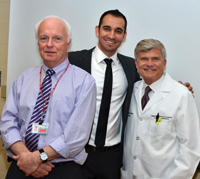Grand Rounds Emphasizes Need for Creativity & Collaboration in Oral Health Care

On May 1, 2013, Mohamad Ayad Kamel DMD 13 presented the third in a series of Grand Rounds presentations for the 2012–13 academic year. Each Grand Rounds session highlights a selected case documented by a student during their 10-week Externship rotation. Kamel’s presentation was based on a patient he treated during his externship at the South End Community Health Center.
Kamel presented the case of a 69-year-old Caucasian male with Huntington’s Disease, a neurodegenerative genetic disorder that affects muscle coordination and leads to cognitive decline and psychiatric problems. The symptoms of Huntington’s Disease include severe chorea (uncontrollable jerky movement), dementia, anger and unprovoked violence, and severe depression. While symptoms can be controlled, the disease is degenerative and has no cure.
In constructing a treatment plan for this patient, Kamel highlighted the importance of considering and incorporating the deterioration of the patient’s health from disease over time. Numerous other challenges added to the complexity of this case: physical hindrances to treatment, such as difficulty sitting still and opening the mouth wide; treatment plan compliance issues due to the disease; financial difficulties; transport difficulties; and lack of a regular caretaker.
Kamel approached the case by first assembling a treatment plan for the patient that might be implemented under ideal conditions—no disease progression, proper hygiene, and sufficient financial resources. He then adjusted this plan to fit the reality of the patient’s situation.
Professor of General Dentistry Dr. Carl McManama moderated a lively discussion following Kamel’s presentation. The discussion highlighted the necessity to map out a unique treatment plan for this patient due to the symptoms of disease and its degenerative progression. Dr. McManama pointed out that creativity is needed in treating uncommon cases that will arise throughout a dental career and advised students that cases will not always match those that appear in their textbooks.
Faculty and students also discussed the importance of collaboration between medical professionals in different specialties, in this case and in general. Dean Jeffrey W. Hutter commented, “This is a perfect example of interprofessional care and demonstrates the importance of oral health care as part of a team collaboration.”
In summary, the case presented by Kamel in Grand Rounds points to two important areas in dentistry today that will be increasingly significant as the generation of Baby Boomers ages: that special needs and elderly cases will present unique challenges that will require creativity in treatment planning in addition to interprofessional collaboration between health care workers.